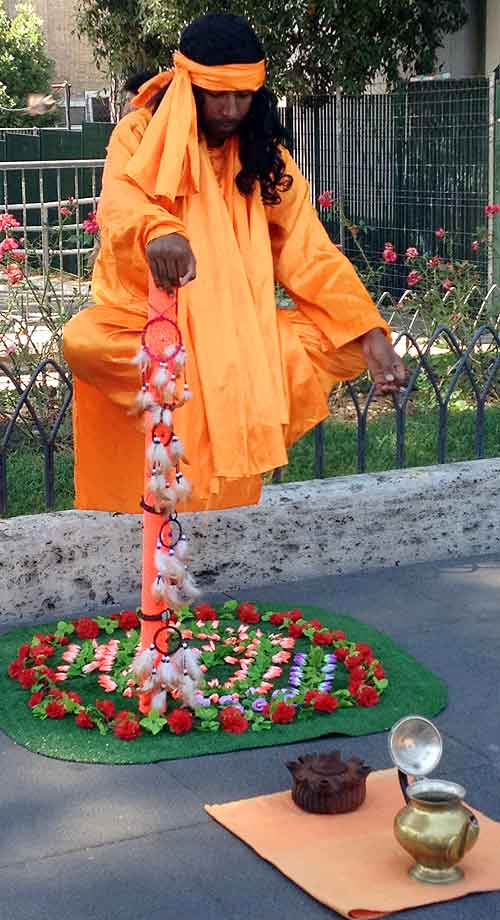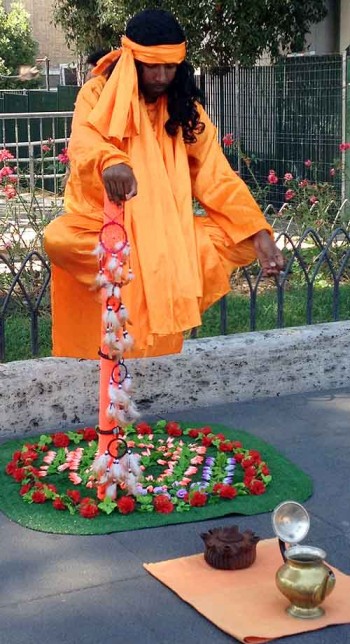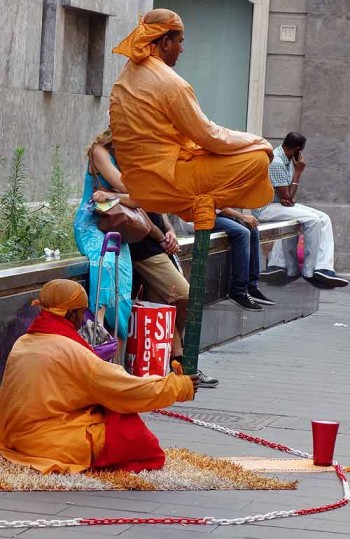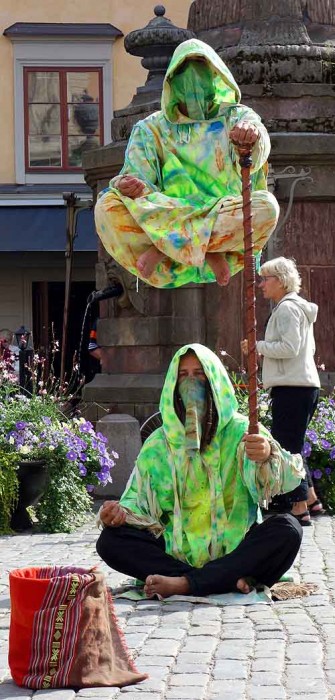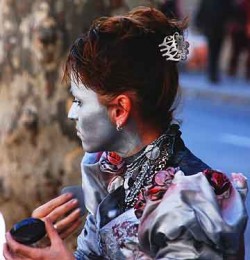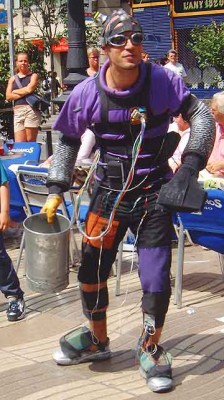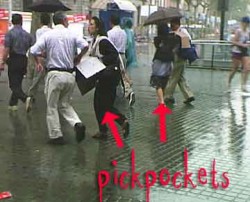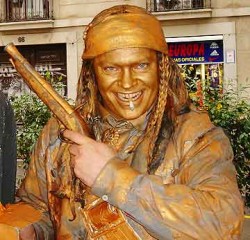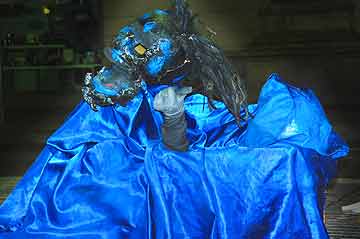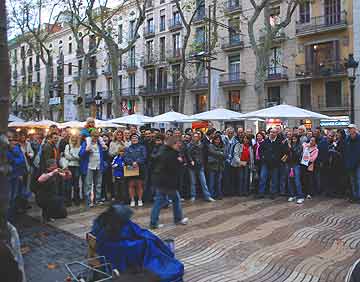What do thiefhunters on vacation do to unwind from workdays detecting and preventing crimes against world travelers? We grab a cocktail, and hobnob with the stars! Here’s what happens when Bob Arno and I attempt to get away for a day of fun-n-frolic in Tinsel Town, with our California colleague Dave “Wiggy” Wiggins. (Hint: simply flipping off the workaday switch is not that easy.)
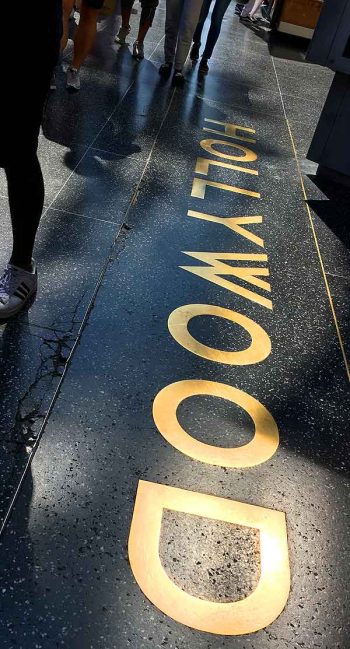
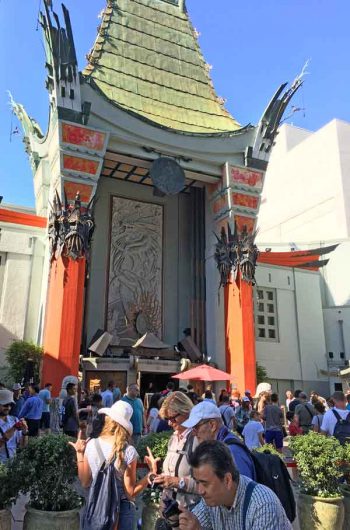
The costume-clad and the snake-draped, the card-trickers and drum-beaters, the picture-posers and the star-counterfeiters, all are there to grab a tourist buck or two.
While enjoying the summer season in “The Golden Orange,” Bob and I met up with our colleague Dave Wiggins for a day of sight-seeing in Hollywood. Bob was just coming off his latest star turn on a Steve Harvey show, so Hollywood is nothing new. But rarely do we have the time to be simply tourists on the legendary Hollywood Walk of Fame.
Dave Wiggins, tourism safety specialist
Our companion this day is well-known in California (and Hollywood in particular) as one of the world’s leading experts on crimes against tourists and best practices in visitor venue safety and security. Dave Wiggins is a 27-year veteran (retired) of California law enforcement, with deep expertise in preventing, investigating, and prosecuting tourism related crime. He helped develop a variety of different tourism security and service programs which came to be viewed as national role models.
For years “Wiggy” organized the nation’s largest conference on tourism safety and security matters. Today, he leads the first ever professional association dedicated to advancing the cause of better protecting travelers. As president of the California Tourism Safety & Security Association, he continues to conduct security assessments and training programs for tourism businesses, as well as security and law enforcement teams. He has been accredited by the American Hotel & Lodging Association as a Certified Lodging Security Director (CLSD), and is an expert in hospitality security as well.
As a former security director in Hollywood, Wiggy knows the streets of Tinsel Town better than most. When we meet up in front of the famed Dolby Theater (home to the Academy Awards) the order of the day is simply socializing. Strolling over sidewalk stars and cement foot prints, followed by cocktails at Hollywood & Highland.

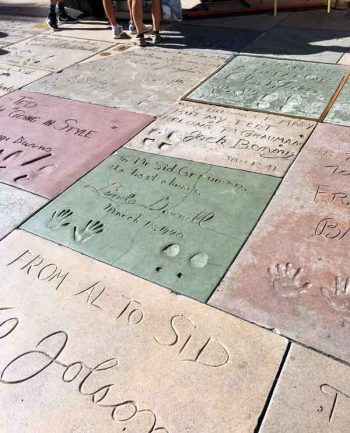
I doesn’t take long for Plan A to devolve into a Walk of Fame version of thiefhunting.
Never the shy one, Wiggy strips off his professional clothing right in the busy parking garage. Slacks, buttoned down shirt, and Maui Jim sunglasses are quickly replaced with cheap shades, tacky shorts, and a Hollywood souvenir t-shirt. The transformation is swift and amazing. Wiggy now looks like he just stepped off the bus from Topeka.
Hollywood Walk of Fame
On Hollywood Boulevard, we’re swept up in a swirling sidewalk sea of humanity which rivals New York’s Times Square or the Las Vegas Strip. Millions of visitors every year come to see such landmarks as the Pantages Theater, Madam Tussaud’s Wax Museum, the Chinese Theater, Ripley’s Believe It Or Not, the El Capitan Theater, Fredericks of Hollywood, the Magic Castle, Hollywood Bowl, Capital Records building, Jimmy Kimmel’s television studio, and the famous home of the Oscars.
But what causes these same visitors to trip over their own feet are the cement stars planted into the glimmering sidewalks of Hollywood Boulevard. It was this blocks-long string of inlaid stars that became Hollywood’s first official tourist attraction.
Initiated in the 1950’s, the Walk of Fame today comprises over 2,600 inlaid stars, commemorating a variety of popular performers and entertainment industry leaders.
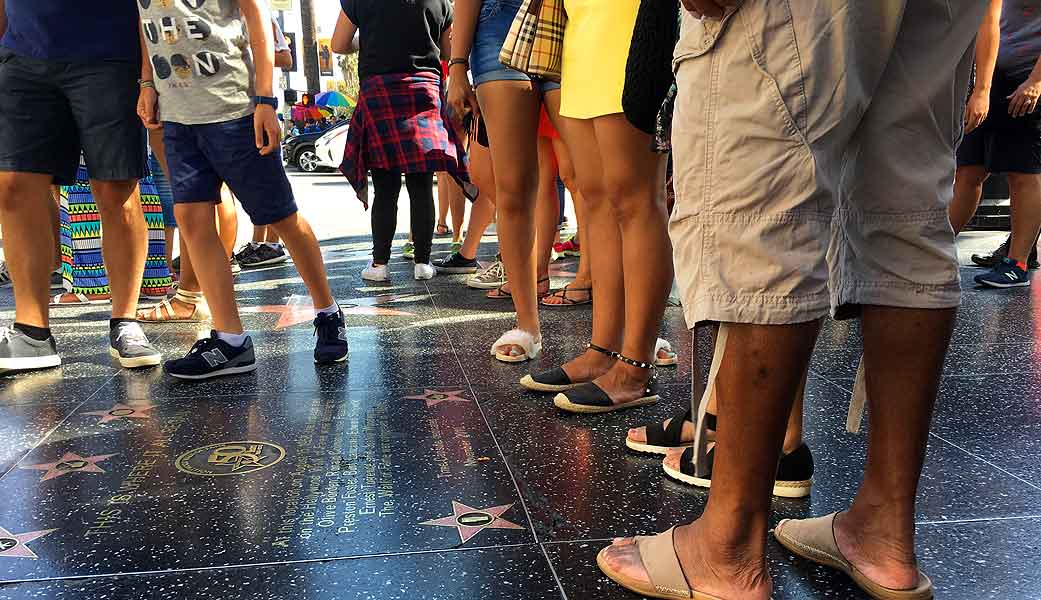
Wiggy offers us a bit of perspective on the Walk of Fame. “People wanted to come see Hollywood,” he explained, “but the motion picture industry was not a place. The principal studios that make up ‘Hollywood’ were scattered all around, from the Santa Monica mountains to the San Fernando Valley, throughout Hollywood and mid-city areas of Los Angeles. So, creating the Walk of Fame gave a far-flung industry a more centralized attraction for tourists.”
The irony, Bob points out, is that you’ll never see an actual celebrity anywhere along the tourist zone of Hollywood Boulevard. To get a glimpse of living stars in the flesh, you’ll need to slide down to Sunset Boulevard, and head west toward Sunset Plaza.
Sidewalk congestion, attractions, and distractions make an ideal environment for crooks
Nevertheless, a cottage industry of businesses catering solely to tourists has sprung up along the Boulevard. Most recently, a spectacular retail, dining, and entertainment complex has been developed at Hollywood & Highland. A variety of vendors and street performers block the sidewalks with their displays and shows. On a busy summer day, it can be hard to move on the sidewalks, which are even more congested than the area’s infamous freeways. Pedestrians spill into traffic lanes as they navigate the crowds and board buses for tours of the stars’ homes. Pedestrian safety has become a hot button topic.

I pause to admire the stars of Groucho Marx and Tony Curtis. But the boys’ heads spin to gawk at a pair of the street performers nearby, a duo of skin-tight black pleather-wearing Cat Women standing tall in stiletto boots. The male of the human species may be biologically compelled to have a wandering eye, but no one can claim they are especially sly about it!
The curvaceous ladies are in good company. The Boulevard is home to scores of cinematic and cartoony characters. The antics of the many street performers along Hollywood Boulevard serve to satisfy the need of tourists to see Hollywood, while obstructing the already congested sidewalk even more. And as we’re well aware, this clogged sidewalk and its many attractions and distractions make an ideal environment for crooks. Like tourism venues elsewhere, the street performers contribute to a climate of disorder which serves the purposes of opportunistic criminals.
In a flash, Wiggy has Bob posing for a souvenir photo with a lanky Cat Woman. Our R&R is off to a good start, it seems. But just as fast, their pose is suddenly photobombed by Jack Sparrow, Marilyn Monroe, Captain America, and a girl wielding two armfuls of live snakes. Uninvited, they crowd the shot. And once snapped, they all demand payment for the pic.
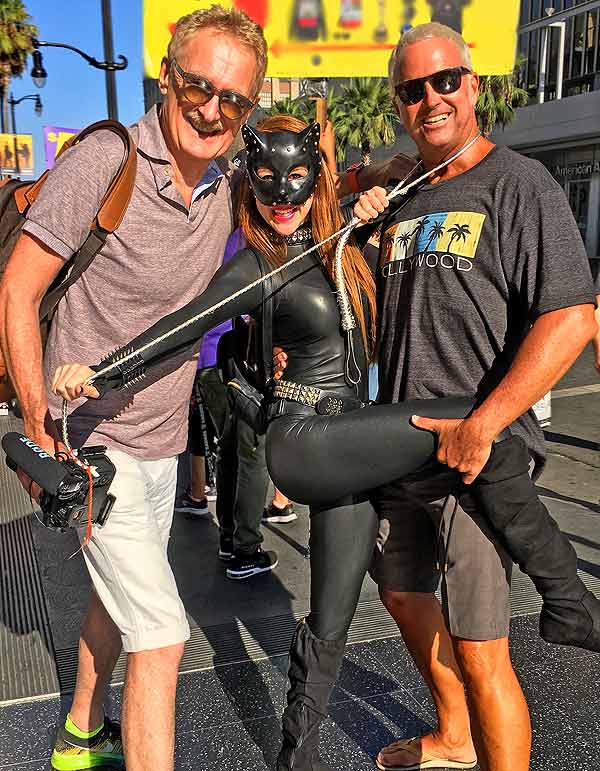
As Bob notes, street performers and related scams are a common problem at tourism venues around the world. From the Colosseum in Rome, to Fisherman’s Wharf in San Francisco, street performers are notorious not only for creating the conditions which facilitate crimes, but sometimes engaging in crimes themselves.
While Wiggy fends off the spurious claims and hands over two dollars to Cat Woman alone, many tourists are intimidated and end up paying all of the photographic interlopers. It goes on all day, every day, all summer, says Wiggy.
And that’s just the tip of the street disorder in this tourist mecca.
An army of career criminals at tourism destinations across the globe work tirelessly at their nefarious trades to make things even tougher for travelers.
—Dave Wiggins
When Bob turns around to continue our stroll along the Walk of Fame, his trained eye instantly catches two locals, their backs planted against a store wall, one leg cocked up, intently observing preoccupied tourists. These are career criminals who prey specifically on tourists—distraction thieves who take advantage of the built-in madness of a place like Hollywood Boulevard.

Wiggy bumps into a couple of former colleagues and soon Bob is engaged in deep conversation with the local constabulary about current trends impacting tourism. Suddenly our day of leisure is looking like another workday.
To be fair, the issues and problems in Hollywood are no worse than any major tourism destination. But as Wiggy observes, one feature makes Hollywood Boulevard distinct: “Nowhere in the world are more people more focused looking straight down.”
Bob is an expert on how just such distractions facilitate victimization, so this turns into a lively discussion on tourism crime around the globe. So much for a day of R&R.
Such is the life of a thiefhunter on vacation.


